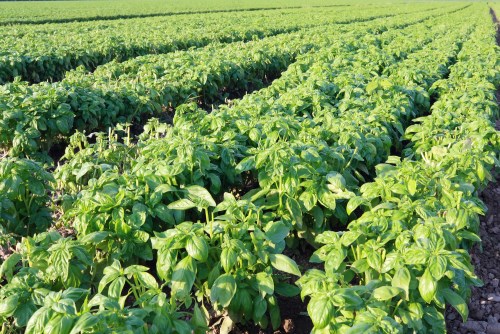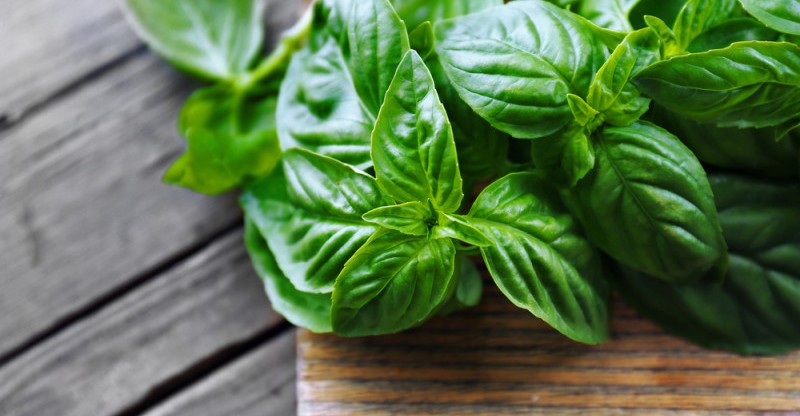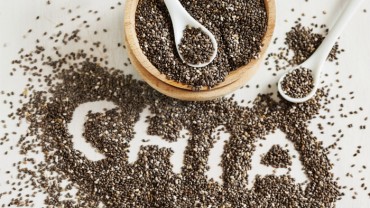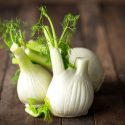21 Evidence-Based Benefits of Basil
Many herbs provide excellent flavor to dishes, and most herbs are known for their healing properties or health benefits.
But which herbs provide the most benefits?
Well, what else could it be? Of course, it’s the “King of Herbs” – basil.
Basil substantially enhances dishes with its sweet-but-peppery taste.
And it’s recommended by most health experts.
You can find basil in most grocery stores, and you can easily grow it at home.
Despite being a delicious, nutritious herb, basil definitely goes underappreciated.
To find out more about basil, read on.
We promise you that after reading this article, you’ll be a fan.
History
Reportedly, Basil was first cultivated 5,000 years ago.
Experts disagree about whether it was first grown in India or Africa, but both cultures have been using it for millennia.
There’s even some evidence that sweet basil was used in the Hunan region in 807 BC, so it might have originated in China.
However, Basil wasn’t used in Britain until the 16th century. And after that, it made its way to North America.
Today, the largest exporters of basil are France, Italy, Morocco, and Egypt. In the US, California produces the most basil.
In ancient times, basil represented different things for various civilizations.
The Haitians believed it would protect them, while the Egyptians guarded their tombs and graves by scattering basil leaves on top.
In places like Iran and Malaysia, basil is still planted on the graves of friends and relatives as a sign of love for the deceased.
In Greece, it was used as a symbol of mourning.
In Jewish folklore, basil is considered to be an ingredient that provided strength to fasters.
The root of the word ‘basil’ is the Greek word ‘basilikohn,’ which stands for ‘royal’ or ‘kingly.’
The first written record of basil was in a British book written in the 17th century.
It didn’t appear in American books until about a century later.
There are different theories behind how basil got is a latin name, Ocymum Basilicum.
One theory is that the root of the word ‘basil’ is the Greek word ‘basilikohn,’ which means ‘royal’ or ‘kingly.’
Another involves an ancient Greek myth about Ocimus, who was killed by an armed combatant during battle.
Because basil was once thought to be an antidote to snake venom, the last theory involves the Latin word for snake, ‘basiliscus.’
However, some sources claim that the French came up with the term ‘semer le basilica’ (which means hurling abuses) because the Greeks would scream curses while planting basil.
In the Middle Ages, some people thought basil was poisonous because it couldn’t grow near perennial evergreen shrubs called rues, which were thought to repel poison.
However, others thought basil helped clear the brain and improved mood.
Ancient Greeks and Romans actually thought basil represented malice and evil.
In Crete, basil was considered a symbol of Satan, and people would place basil pots on their ledges to keep the devil out.
Basil wasn’t used in Britain until the16th century, doctors had a bizarre belief that merely smelling basil would cause scorpions to develop in the brain.
It apparently began with an English doctor’s observation: when basil was placed under a damp stone, scorpions would appear in a few days.
In the 17th century, women would refuse to eat a meal if a basil leaf had been placed under the dish.
Another strange belief was introduced by author Francis Bacon: basil could transform into wild thyme if placed under intense sunlight.
So there were clearly many varied theories and assumptions about basil.
But today, it is celebrated as a versatile, beneficial herb.
It works as a tasty condiment in all sorts of foods, and it’ll also help keep you healthy.
How Basil Grows

If you want to regularly include basil in your dishes, then growing it at home is an excellent idea.
Once you get everything set up, it’s actually pretty easy.
And just a few basil plants will prove to be more than enough for a small group of people, so you won’t need a lot of storage space.
One limitation of growing basil is that it isn’t very cold-tolerant.
So if you live in a very cold region, you’ll only have a small window of time to plant basil.
You need to plant it in the summer after the frost is all gone.
Then grow it in a spot that gets maximum sunlight for at least six to eight hours.
Because you’ll be using the leaves while preparing food, make sure you don’t use harmful pesticides or place the plant near running cars because exhaust could settle onto it.
If you want to plant directly outside, wait for the ground temperature to reach at least 70°F.
But if you don’t want to wait for the soil to get warm before planting, you can plant seeds six weeks before the frost goes away, then transport the seedlings outside.
You’ll also have the option of placing a section of a basil plant that hasn’t flowered in the water yet.
Roots will soon form, and you can transplant it outside.
Basil plants need a fair bit of moisture. The soil needs to be moist and well-drained.
If you live in a region that experiences dry summers, you’ll have to water it more frequently.
To keep the plants healthy, it’s also a good idea to place mulch around them.
Place the different basil plants at least 12 inches away from each other.
If you don’t have space or are using a container, spicy globe basil is a good choice because of its compactness.
If you do have space, consider planting tomatoes next to the basil.
They make great partners while they’re growing (as well as in dishes).
If you would rather not plant tomatoes, other good options are lettuce, chamomile, oregano, and pepper.
Although basil plants repel insects, they’re vulnerable to some pests (such as aphids, slugs, or Japanese beetles).
Be wary about these pests, and use a mild pesticide if necessary.
Another problem that basil plants can experience is root rot or other diseases. So to make sure roots are intact, the soil should be well-drained.
Basil should be harvested throughout the growing season (as opposed to all at once).
Even if you’re picking many leaves, make sure at least a third of the leaves are left on the plant.
Once your plants have reached a height of about six inches, you can start picking off some of the leaves.
Pinch the leaves from the tips of the stems, so that more branches can develop.
Also pick off the flowers that develop, because leaves will cease growing if you don’t.
Once the possibility of frost occurs in the winter, you can cut the entire plant and use all suitable leaves (4,5,6).
Varieties
If you love basil, there are between 50 and 150 different varieties to try.
Here are some of the most popular ones:
Sweet Basil
This variety is the most common and readily available.
It’s widely used in a multitude of dishes. Sweet basil plants grow to a height of 14 to 30 inches, and they thrive in hot weather.
Sweet basil has a fresh aroma and sweet taste, and it particularly pairs well with Italian cuisine.
You can try it in Italian sauces, marinades, and soups.
Thai Sweet Basil
As the name implies, this version of sweet basil is mostly used in Southeast Asian cuisines.
The leaves of Thai sweet basil plants are smaller and have pointed, dark-green tips.
Unlike most basil plants, the flowers of Thai basil are deep purple or maroon, and they come in a cone-like shape.
The height can range from 18 to 24 inches, and it has a distinctive spicy taste (almost like anise).
Purple Basil
If you like your garden to have been both useful and pretty, purple basil is a two-in-one package deal.
With its striking deep-purple leaves and stems, it can give your garden a burst of color.
While it isn’t as sweet as other varieties, it has a unique clove-like taste.
Ranging from 14 to 20 inches in height, purple basil also has its own sub-varieties (such as Dark Opal or Purple Ruffles).
Purple basil is great for salads and garnishes, or it can be used for its aroma and color in dishes.
Lemon Basil
If you like lemons, you’ll love this variety.
Lemon basil can grow up to a height of 36 inches, and it has long smooth light-green leaves.
It develops flower spikes that are around five to ten inches long. If you’re genuinely interested in using basil for sophisticated dishes, lemon basil is perfect.
It goes really well with salads, fish dishes, grilled veggies, chicken marinades, desserts, and teas.
Lettuce Basil
It’s easy to tell a lettuce basil plant apart from most other varieties since it has a unique look: it has wide, wrinkled light green leaves that resemble (you guessed it) lettuce.
It has a mild flavor that works well in salads, garnishes, and wraps.
Although its leaves are large (around four inches wide and six to ten inches long), the plant itself only grows to around 12 inches in height.
The flowers of lettuce basil develop later than in most varieties, so the leaves grow longer than usual.
Holy Basil
Holy basil has special significance in the Hindu religion.
Also called the Sacred Basil, it is revered as a symbol of the goddess Tulsi. It is also widely used in Indian cuisine, especially in meat-based dishes.
Ancient Indian people also placed basil leaves on the chests of the dead, so that they could ascend to heaven.
It grows to around 12 to 14 inches tall, and it has dark green spotted leaves. It’s best used in teas or cooked in dishes.
Eaten raw, it gives off a bitter taste. It’s known to improve immunity, blood circulation, kidney health, and stomach problems.
Cinnamon Basil
This variety comes with a delicious fragrance and a spicy taste. It grows up to 30 inches tall.
And with purple stems, pinkish-purple flowers, and neat, shiny leaves, it’s a lovely plant.
Although it has a spicy cinnamon flavor, it’s mild enough that it can be used in dishes without the fear of overpowering other flavors.
It goes well with fruit salads, Asian marinades, noodles, fried rice, and grilled vegetables.
Cardinal Basil
Cardinal basil enhances the appearance of any garden. As its name implies, it produces bright red flowers, which are tightly packed together.
It can grow up to 30 inches tall, and it has small light-green leaves.
Cardinal basil has a stronger taste than most varieties, and it can give a powerful kick of spice to oils, kinds of vinegar, or marinades.
Spicy Globe Basil
Spicy Globe basil (also known as Spicy Bush basil) is the perfect choice for those who don’t have much space to grow basil.
Spicy globe basil usually only grow to 10 or 12 inches, so it’s a compact plant.
It has small leaves with serrated edges, but it packs an intense flavor.
It works well in soups, sauces, and kinds of pasta.
Christmas Basil
A cross between Thai sweet basil and Genovese, Christmas Basil is versatile.
It can be grown in containers, and it works great as an ornamental plant. It grows from 12 to 18 inches in height, and it has big, glossy leaves and purple flowers.
Its fruity taste makes it suitable for salads, desserts, and drinks.
Because of its rich, pleasant aroma and striking flower bracts, it’s commonly used in wedding bouquets (7, 8).
Interesting Facts
There are lots of fun facts about basil:
- Basil is versatile. It can be used fresh, but it can also be used in its dry form. It can be used in both savory and sweet dishes.
- In folk medicine, the use of basil is quite popular. Basil tea is often useful, and it’s used to treat everything from constipation and stomach cramps to anxiety and depression.
- Basil contains certain chemicals that insects don’t like (although they don’t affect humans). In particular, mosquitoes don’t like basil. So if there’s one herb you want nearby in the heat of the summer, it’s basil.
- Basil is revered in different religions. In addition to being considered holy by Hindus, Orthodox churches in some countries (such as Bulgaria, Slovenia, Macedonia, and Serbia) use basil to prepare holy water (10).
- Basil is part of the mint family. Some other common herbs in the mint family are oregano, rosemary, and lavender.
- Different kinds of basil plants give off different scents. Each variety of basil has a different combination of essential oils. So they can smell like lemons, cloves, camphor, or licorice.
- Basil plants usually produce small white flowers, but some varieties have purple flowers. Similarly, the purple basil plant has stems and leaves that have a burgundy hue.
- However, there’s now is an Italian saying: “Where salt is good, so is basil.”
- In Chinese, the name for Thai Basil in Chinese translates to “won’t be exchanged, even for gold.” (11)
Nutritional Facts
Basil is rich in both culinary and nutritional values.
Here is a breakdown of the nutritional content of a ½ cup (21.20 grams) of basil:
Vitamin K: 87.94 mcg (98 %DV)
Manganese: 0.24 mg (12 %DV)
Copper: 0.08 mg (9 %DV)
Vitamin A: 55.91 mcg RAE (6 %DV)
Vitamin C: 3.82 mg (5 %DV)
Calcium: 37.52 mg (4 %DV)
Iron: 0.67 mg (4% DV)
Folate: 14.42 mcg (4% DV)
Magnesium: 13.57 mg (3% DV)
Omega-3 Fats: 0.07 g (3% DV)
Basil has other nutrients too, but in negligible amounts.
It packs very few calories, and almost no carbohydrates and fat content.
It also scores very low on the Glycemic Index (14).
21 Science-Backed Health Benefits of Basil
As we’ve said before, basil has plenty of health benefits.
Here are some of them.
Anti-inflammatory Benefits
Inflammation is your body’s biological response to harmful or irritating stimuli.
It is your immune system’s way of removing that stimulus or getting rid of foreign bodies.
Therefore, acute inflammation is a good thing, and its response is key to your survival.
On the other hand, chronic inflammation can actually cause illnesses, rather than treat them.
Chronic inflammation can lead to a number of conditions (including atherosclerosis, periodontitis, and hay fever) (15).
Basil has a component called (E)-beta-caryophyllene (BCP) that soothes inflammation.
A study has shown that holy basil can reduce swelling by up to 73% in less than 24 hours (16). Other studies mirror these results (17, 18).
Protects Against Arthritis
Arthritis is a pain in the joints (or joint disease). More than 50 million adults (and 300,000 children) suffer from arthritis, which can affect people of all ages, sexes, and races.
Arthritis involves stiffness, swelling, and pain. Some kinds of arthritis can affect organs, such as the heart, eyes, lungs, kidneys, and skin.
In the United States, it is the most prominent cause of physical disabilities (19).
Basil contains high amounts of beta-caryophyllene. A study conducted at the Swiss Federal Institute of Technology revealed that beta-caryophyllene can treat arthritis (20).
And another study showed that the chemical effectively cured rats of arthritis (21).
Antibacterial Properties
Basil has a combination of different essential oils. These oils can protect you from harmful bacteria and microbes.
Pathogenic bacteria can cause various illnesses, such as strep throat, cholera, tuberculosis, staph infections, and food poisoning.
These bacteria and microbes can infect you if you’re living in unsanitary conditions, and they can replicate very quickly (22).
But many studies have proven that basil can prevent these bacteria from taking over.
The essential oils in basil (such as ecogole, inalool, cineole, eugenol, sabinene, myrcene, and limonene) inhibit the growth of bacteria. Similarly, they can protect you from yeast, MLD, and viruses (23).
Rich in Antioxidants
The main purpose of consuming foods that’s sources of antioxidants is to balance the number of free radicals in your body.
Free radicals are highly reactive molecules. They can cause oxidative stress, which can damage the proteins, molecules, and genes that are necessary for your health.
Antioxidants can neutralize free radicals in your bloodstream, and repair damaged molecules.
With its high vitamin C content, basil has been shown to effectively counter oxidative damage (25).
By regularly eating basil, you can ensure that you’re adding to the natural antioxidants produced by your body.
And it protects your cells and organs from deterioration.
Helps Fight Cancer
Cancer occurs due to abnormal cell growth.
Mutated cells can multiply and invade different tissues, causing you to lose normal bodily function.
There are more than 100 different types of cancers, which all have their own symptoms (26).
The treatment for cancer includes chemotherapy, radiation, or surgery.
But these treatments are only successful a fraction of the time.
In addition, these treatments are costly, and they might have side effects and complications.
But with basil, you can take a preventive approach. Basil prevents the spread of malignant cells and supports the death of harmful cells (27).
Studies have shown that it also protects normal cells during chemotherapy or radiation.
So it’s beneficial for those who already have cancer and are undergoing treatments (28).
Helps Treat Diabetes
Diabetes is a condition that causes high blood-glucose levels.
Symptoms include frequent urination, unusual weight changes, intense hunger and thirst, fatigue, slow healing of wounds, numbness, tingling in the limbs, and male sexual dysfunction (29).
Basil has been shown to reduce glucose levels.
In addition, it alleviates the unhealthy levels of cholesterol and triglyceride that diabetes can cause.
Azad University of Agriculture and Technology in India conducted double-blind clinical trials to test the benefits of basil.
They found that it can be safely used for treating or preventing diabetes (30).
Protects the Liver
Some of the primary functions of the liver are bile production and excretion; excretion of bilirubin, cholesterol, hormones, and drugs; metabolism of fats, proteins, and carbohydrates; enzyme activation; storage of glycogen, vitamins, and minerals; synthesis of plasma proteins (such as albumin) and clotting factors; and blood detoxification.
If you get liver disease, these functions cannot be carried out properly.
So you may experience fatigue, nausea, vomiting, and jaundice (32). However, basil has been proven to protect your liver.
A study published in the Journal of Medicinal Food conducted an experiment on rats with liver disease.
It found that basil extract significantly increased the production of detoxifying enzymes and reduced the buildup of fat (33).
Helps Relieve Stress
In herbal medicine, adaptogens are natural substances that help you adapt to stress.
They protect you from the negative effects of all kinds of stress.
In particular, holy basil is an adaptogen, which improves strength, stamina, energy, and mental clarity.
An experiment conducted on rabbits showed that fresh basil leaves could significantly reduce stress.
The rabbits were placed in a high-stress environment, then given two grams of basil each day for an entire month.
They displayed improved respiratory and cardiovascular protection and decreased blood sugar levels and oxidative stress (35).
Basil is an Aphrodisiac
Infertility can be due to poor sperm quality or erectile dysfunction.
An inability to maintain an erection isn’t a big problem if it only occurs once in a while, but it can poorly impact your confidence and relationship if it happens frequently.
Historically, basil has been considered an aphrodisiac.
In Italy, it was considered a symbol of love, and in Ayurveda, it is thought to improve arousal. In Portugal, it’s still a romantic gift given to lovers.
Research has also indicated that it can improve problems with erectile dysfunction (36).
Anti-aging Properties
One of the consequences of oxidative stress is both physical and mental aging.
It can lead to signs of aging and reduce your cognitive abilities.
However, basil can keep you looking and feeling youthful (38).
Free radicals can damage the quality of your skin, while exposure to harmful ultraviolet rays can cause wrinkles and dark spots.
Because it’s rich in antioxidants, incorporating basil into your regular diet can combat these effects (39).
Improves Bone Density
Your bones are very important for your health.
They support your structure, and they’re needed for proper movement.
As you age, your bones can lose density, which can particularly impact women after menopause sets in.
Their bones can become brittle, and fractures can easily occur.
Basil is one of the best sources of vitamin K, which helps maintain bone density.
And calcium cannot be used by your body without vitamin K.
Research has shown that people who ingest food that’s rich in vitamin K have a 65% lower chance of fracturing their hips (40, 41).
A study conducted on athletes has also supported this conclusion (42).
Improves Blood Clotting
Proper blood clotting is integral to your survival and well-being.
Also known as coagulation, blood clotting prevents excessive bleeding when one of your blood vessels suffers an injury.
Proteins in blood plasma combine with platelets to form clots, which prevent excess bleeding (external or internal).
Many proteins are needed to form blood clots, and each clot requires at least 12 proteins.
And vitamin K is needed for the activity of 4 of them. Therefore, basil helps heal bruises and cuts.
In newborn babies, inadequate clotting can lead to hemorrhagic disease, which can be countered with the help of vitamin K (43).
So by eating lots of basil, you can ensure that blood clots are properly formed.
Keeps your Brain Healthy
As you grow older, you begin to lose the sharpness you enjoyed during youth.
But you can prevent cognitive decline by regularly using basil.
The vitamin K in basil is involved in a process called sphingolipid metabolism.
Sphingolipids are molecules that help protect the brain from oxidative stress (44).
Basil also contains manganese, which can cause neurotransmitters to create electric impulses that conduct faster, so you’ll have better reflexes and mental processing abilities (45).
Copper is also a brain stimulant, which prevents mental disorders from setting in (46).
Can Prevent Epilepsy
Epilepsy is a chronic neurological disorder characterized by recurrent, unprovoked seizures.
Seizures can affect your safety, especially if it occurs while driving or working with dangerous items (such as fire or knives).
It can severely reduce the quality of life of patients, especially if they don’t have access to proper healthcare.
One of the triggers of epileptic seizures is a low level of manganese.
Basil has high manganese content, and using it regularly can ensure that your body is not suffering a manganese deficiency.
The exact reason isn’t known, but it might be because of manganese functions as a vasodilator (47).
Supports your Body’s Metabolism
Metabolism includes chemical reactions that are involved in maintaining the living state of cells and organisms.
When this process is disrupted, you can develop metabolic disorders.
Manganese can regulate metabolism.
It supports enzymes that help in the metabolism of cholesterol, amino acids, and carbohydrates.
Furthermore, it is needed for the metabolism of several glucose-related vitamins, including Vitamin B-1 and Vitamin E (48, 49).
Similarly, the copper in basil allows different enzymes in your body to function properly (50).
These enzymes are necessary to maintain proper metabolism.
Helps Alleviate PMS
The premenstrual syndrome involves a range of symptoms that may occur in women before or during their menstrual period.
It is estimated that around three in every four menstruating women experience PMS.
The symptoms of PMS include pain, irritability, depression, fatigue, mood swings, breast tenderness, and food cravings.
Studies have found a correlation between low levels of manganese and PMS.
Therefore, manganese can promote hormonal balance and help overcome PMS (51).
If you frequently experience PMS symptoms and want to deal with them without resorting to medication, basil can be a good solution.
Keeps your Thyroid Gland Healthy
Your thyroid gland releases hormones that control metabolism and regulate vital body functions.
It’s partially responsible for maintaining your breathing, heart rate, body weight, muscle strength, body temperature, and cholesterol levels.
Problems in your thyroid gland can affect your life in many ways.
Hyperthyroidism can cause anxiety, moodiness, nervousness, sweating, tingling, trembling, and missed periods.
Hypothyroidism can lead to insomnia, fatigue, concentration problems, dry skin and hair, depression, heavy periods, and cold sensitivity.
Basil has manganese, which promotes the proper functioning of the thyroid gland.
Therefore, adequate manganese levels ensure that there isn’t an overproduction or underproduction of thyroid hormones (52).
Increases your Energy Production
All of us have experienced lethargy. We’ve all felt tired, and wanted nothing more than to curl up and sleep.
But while it’s normal to feel that way from time to time, it becomes a problem if you’re constantly weary.
Fatigue can disrupt your life, both socially and professionally. Basil can prevent exhaustion that’s due to a copper insufficiency.
Copper is a requisite for the synthesis of adenosine triphosphate, which creates energy (53).
Keeps your Digestive System Healthy
Your digestive system plays an extremely important role in your health.
Proper digestion is needed for your body to get all the nourishment it needs, and it forms a large part of your immune base.
The manganese found in basil helps your digestive tract remain healthy and perform well.
Therefore, it allows for the better absorption of fat and prevents constipation and irritable bowel syndrome.
It also ensures that you don’t get vitamin deficiencies — by aiding the proper absorption of vitamins (such as vitamin B and vitamin E) (54).
Similarly, copper aids in the digestion of iron in the digestive tract (55).
Keeps your Eyes Healthy
We often take our sense of sight for granted.
But poor vision can hamper our everyday lives to a degree greater than we realize.
As you get older, it’s normal to experience weakening eyes.
One of the things you can do to prevent this condition is eating more basil.
Basil has lots of beta-carotene, which has been shown to reduce the chances of developing muscular degeneration.
Studies also show that vitamin A can protect you from dry-eye syndrome and Stargardt’s disease (56).
Ascorbic acid (also found in basil) helps prevent cataracts (57).
How to Buy and Store Basil
Basil is best used by directly picking it off the plant.
However, if you don’t have basil growing at home, make sure it looks fresh.
Basil isn’t fresh if you see dark spots on the leaves or the stems are droopy or moldy.
The leaves should look smooth and vibrant and have a strong smell.
Although basil plants thrive in the sunlight, it should be kept away from direct sunlight if it’s already been picked.
If you buy basil with roots, don’t cut them off.
Then trim off the bottom of the stems and place the plant in a vase with a few inches of water in it.
It’s best to store fresh basil at room temperature.
Make sure to ingest it within two to four days of purchase.
However, if you want to store basil for longer, you won’t be able to dry it as you’d dry other herbs.
Because basil has high water content, it’ll go black and lose its flavor if it’s cut up and exposed to air.
Freezing basil is a good way to store it.
First, remove the leaves from the stems.
Then carefully rinse the leaves.
Keep in mind that the leaves are delicate, so they might easily bruise.
Then using a salad spinner, leave the leaves out on a towel to dry or drain excess water.
Once you’ve prepared the basil leaves and buds, place them on trays and put them in the freezer for a couple of hours.
Then put them inside airtight containers.
Don’t pack too much in one container.
When you need to use the leaves, just defrost them and use them as you please.
Another method is to clean out an empty milk carton and cut off the top.
Place the leaves inside the carton, then seal the top.
Put the carton in a Ziploc bag.
Whenever you need basil, you can take out a little bit and seal the carton off again.
If you don’t need whole basil leaves, you can also puree the basil with olive oil, place the puree in ice trays, and keep it in a container in the freezer.
If you want to dry the basil, you can bake the leaves for two to four hours at a low temperature in the oven, crumble the leaves, and store them in an airtight container (61, 62).
Precautions
There are very few side effects of basil.
For those who already suffer from low blood sugar or low blood pressure, using basil as medicine can exacerbate your condition.
If you’re using basil as a medicine in the long-term, there might be chances of developing liver cancer because of a chemical called estragole.
For the same reason, large quantities of basil might be unsafe for pregnant or breastfeeding women or young children.
If you have a bleeding disorder, basil oil might slow down blood clotting.
Therefore, you should stop using basil around two weeks before a scheduled surgery (67).
Conclusion
If you aren’t already a believer in the powers of basil, try using it more, and see for yourself!
It works nicely in many different kinds of dishes and drinks, so it’s easy to make sure you’re getting all its benefits from your diet.
Basil truly is one of the best ingredients to work within the kitchen.
It boasts:
- Numerous vitamins and minerals
- Low levels of fat, sugar, and carbs
- The ready availability and a cheap price
Whether you’re cooking for yourself, your friends, or your family, use some basil leaves to make it healthy for everyone.
In the long run, you’ll definitely be thankful you did!
FDA Compliance
The information on this website has not been evaluated by the Food & Drug Administration or any other medical body. We do not aim to diagnose, treat, cure or prevent any illness or disease. Information is shared for educational purposes only. You must consult your doctor before acting on any content on this website, especially if you are pregnant, nursing, taking medication, or have a medical condition.
HOW WOULD YOU RATE THIS ARTICLE?







Does dried basil keep its benefits?
Hope adding more basil to my diet will help me relieve during PMS, I’m tired of taking pills!
The interesting facts and history sections make this post different from other usual materials about basil. I enjoyed reading the article! Thanks!
Good Evening,
I am looking for researches able to back this part :
”The manganese found in basil helps your digestive tract remain healthy and perform well.
Therefore, it allows for the better absorption of fat and prevents constipation and irritable bowel syndrome.me.”
Thank you so much for your time,
Héloïse